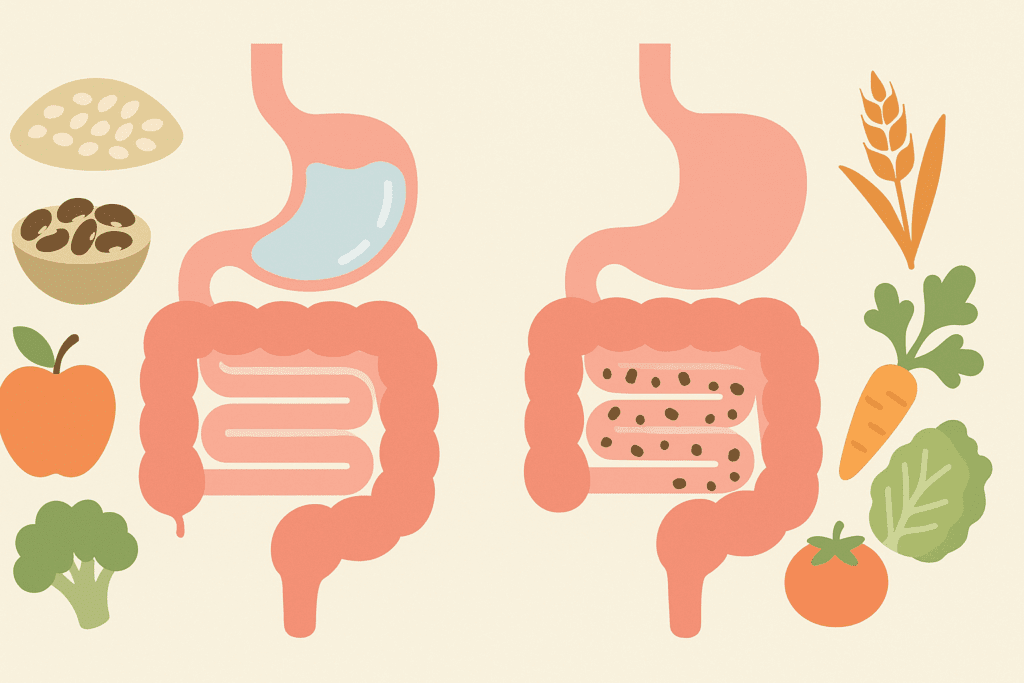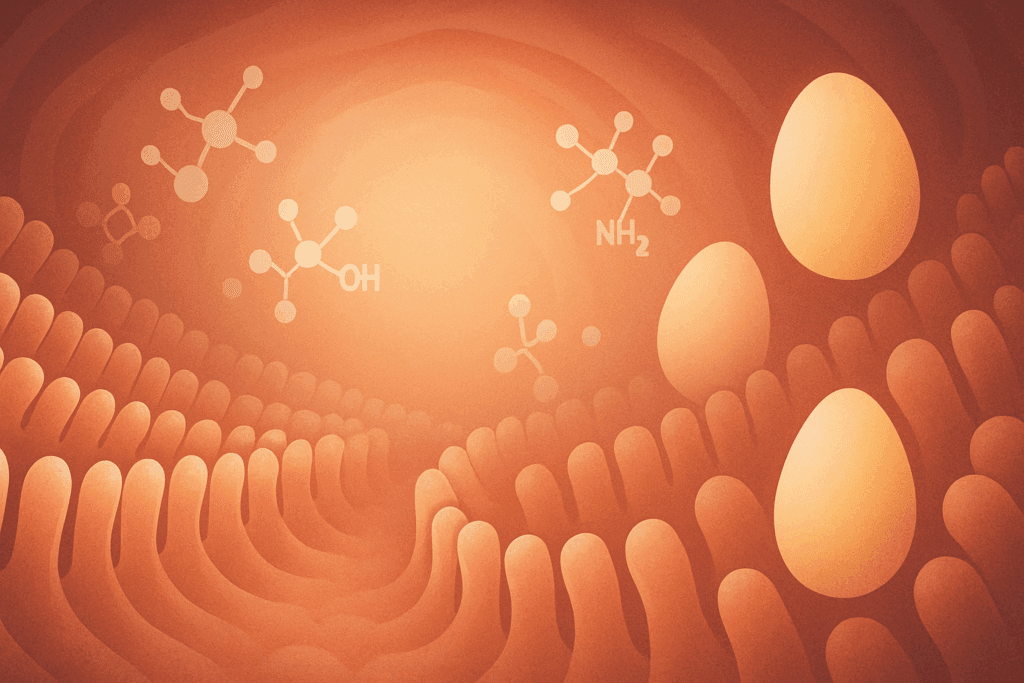In the realm of nutritional science and digestive wellness, few foods spark as much curiosity and confusion as the humble egg. Praised for its high protein content, versatile culinary uses, and micronutrient density, the egg has long held its place as a staple in diets around the world. However, in the context of gut health and fiber intake, a more nuanced conversation emerges. Many people wonder about the role of fiber in eggs and whether eggs qualify as a high fiber breakfast food. This question gains importance as awareness around gut health and the microbiome continues to grow. While eggs deliver many essential nutrients, their relationship with dietary fiber—a cornerstone of digestive health—is often misunderstood. In this article, we will explore the surprising truth about fiber in eggs, addressing common misconceptions, dissecting scientific evidence, and examining their place in a fiber-rich, gut-friendly diet.
You may also like: The Ultimate Guide to Gut Healthy Meals: Best Meals for Gut Health and Nourishing Recipes You’ll Love

Understanding Dietary Fiber and Its Critical Role in Gut Health
To evaluate whether eggs qualify as a high fiber breakfast food, we must first understand what dietary fiber is and why it is essential for gut health. Dietary fiber is a type of carbohydrate that the body cannot digest. Unlike other carbohydrates, fiber passes through the digestive system largely intact, helping to regulate the body’s use of sugars and contributing to satiety, digestive regularity, and a healthy microbiome. There are two primary types of fiber: soluble and insoluble. Soluble fiber dissolves in water and forms a gel-like substance in the gut, which can help reduce blood cholesterol and glucose levels. Insoluble fiber, on the other hand, adds bulk to stool and supports movement through the digestive tract.
Both types of fiber play complementary roles in supporting digestive function and overall health. Numerous studies link high fiber diets with a reduced risk of heart disease, type 2 diabetes, obesity, and certain types of cancer. From a gut health perspective, fiber acts as a prebiotic—feeding beneficial gut bacteria and promoting a diverse and resilient microbiome. The importance of fiber in maintaining gastrointestinal balance and preventing conditions like constipation, irritable bowel syndrome (IBS), and diverticulitis cannot be overstated. Therefore, the notion of including high fiber breakfast foods as part of a holistic health strategy is both evidence-based and widely supported by nutrition experts.

Dispelling Myths: Do Eggs Have Fiber?
One of the most commonly asked questions about eggs is: do eggs have fiber? At first glance, it might seem like a simple inquiry, but the answer reveals a broader misunderstanding of egg nutrition. Despite their many benefits, eggs do not contain dietary fiber. This fact often surprises individuals who assume that because eggs are whole foods and natural sources of nutrients, they must also contribute to fiber intake. However, nutritional data confirms that both egg whites and egg yolks are devoid of fiber. This includes all standard preparations, whether the egg is boiled, scrambled, poached, or fried.
The absence of fiber in eggs is not necessarily a drawback, but it does necessitate intentional pairing with other foods to round out a balanced, gut-supportive meal. In isolation, relying solely on eggs for breakfast without incorporating other fiber-rich components can lead to suboptimal digestive outcomes. For instance, a breakfast of eggs and bacon may provide ample protein and fat but lack the fiber necessary to promote satiety, bowel regularity, and microbial diversity. Thus, the key to utilizing eggs effectively within a fiber-conscious diet lies not in the eggs themselves, but in how they are integrated with other ingredients.

Are Eggs High Fiber Food? An Evidence-Based Perspective
Given that eggs do not contain dietary fiber, the question “are eggs high fiber food?” is, from a technical standpoint, easy to answer: no, they are not. However, the broader context of this inquiry often relates to whether eggs can be part of a high fiber breakfast when consumed in conjunction with other foods. When viewed through this lens, eggs can indeed play a supportive role in a fiber-forward meal, especially when paired with vegetables, legumes, whole grains, or fruits.
For example, an omelet filled with spinach, tomatoes, bell peppers, and black beans served alongside a slice of whole grain toast or a bowl of steel-cut oats transforms eggs from a low-fiber food into a component of a meal rich in both soluble and insoluble fiber. The key is to recognize that while eggs themselves are not a source of fiber, their culinary versatility allows them to be easily combined with fiber-dense ingredients. This integration is vital for individuals aiming to meet the recommended daily intake of 25 to 38 grams of fiber.
This distinction underscores a recurring theme in nutrition science: no single food determines dietary adequacy. Instead, the quality of one’s overall dietary pattern is what shapes long-term health outcomes. Eggs are nutrient-dense and satiating, offering essential amino acids, choline, B vitamins, and antioxidants like lutein and zeaxanthin. Their ability to complement high fiber breakfast foods makes them a valuable ally in building meals that are both satisfying and supportive of digestive health.

Exploring the Science Behind Fiber in Eggs: What Research Really Says
Scientific literature consistently affirms that eggs do not contain fiber, which is why the phrase “fiber in eggs” can be misleading if taken out of context. Yet, the search volume and curiosity surrounding this topic suggest that people are eager to understand how eggs fit into fiber-conscious diets. Some confusion may arise from the broader health halo surrounding eggs, which are often marketed as “complete” or “nutritionally balanced.” While eggs excel in protein quality and micronutrient density, fiber is the one macronutrient they lack entirely.
Despite this, emerging research has examined the synergistic effects of combining eggs with high fiber foods. Studies indicate that meals combining high-quality protein and dietary fiber can enhance satiety, improve glycemic control, and support weight management. For instance, a randomized clinical trial published in the American Journal of Clinical Nutrition found that participants who consumed a high-protein, high-fiber breakfast experienced reduced appetite and lower energy intake throughout the day compared to those who consumed meals lacking in these macronutrients.
Furthermore, the combination of fiber-rich carbohydrates and protein slows gastric emptying, prolonging feelings of fullness. This dual mechanism not only benefits digestive health but also supports metabolic outcomes. Therefore, although the idea of fiber in eggs is a nutritional misnomer, the combination of eggs with fiber-rich foods can have significant physiological benefits.

Why People Think Eggs Have Fiber: The Power of Food Perception
Understanding why many people believe there is fiber in eggs requires a look at food marketing, cultural norms, and educational gaps in nutrition literacy. Eggs are often lumped together with other whole foods that are perceived as universally healthy. This broad categorization can lead consumers to assume that all essential nutrients, including fiber, are present in such foods. Moreover, marketing labels emphasizing the health benefits of eggs—such as their role in weight management, muscle maintenance, and brain function—can inadvertently reinforce the belief that they also aid digestive health via fiber content.
Additionally, the popularity of certain egg-based dishes that contain vegetables or whole grains may contribute to this misconception. A breakfast burrito made with eggs, beans, and whole wheat tortillas, for instance, is high in fiber due to its accompanying ingredients. However, the eggs often take center stage in descriptions and images, leading to the false impression that the eggs themselves are a fiber source. This underscores the need for greater public education around the specific nutrient profiles of commonly consumed foods.
The Importance of Pairing Eggs with High Fiber Foods
Given that there is no fiber in eggs, building a gut-friendly meal requires strategic pairings. Fortunately, eggs are among the most adaptable ingredients in the culinary world. Their neutral flavor and flexible texture make them ideal companions to a wide range of high fiber foods. Vegetables such as kale, spinach, mushrooms, and bell peppers are excellent choices to fold into scrambled eggs or omelets. Adding legumes like lentils, chickpeas, or black beans increases both soluble and insoluble fiber content.
Whole grains such as quinoa, oats, barley, and whole wheat bread can serve as nutrient-dense bases or sides for egg-based meals. Even fruits such as avocado, tomatoes, and berries can be incorporated into egg-centric breakfasts to enhance fiber content. For instance, avocado toast with a poached egg on top offers monounsaturated fats, fiber, and protein in one balanced bite. These thoughtful combinations help ensure that eggs contribute to a satisfying, well-rounded meal that supports gut health.
Is There Fiber in Eggs? Clarifying Nutritional Labels and Misconceptions
Many people rely on food labels to guide their dietary choices, and while this can be helpful, it also leaves room for misinterpretation. On egg cartons, one typically sees a breakdown of calories, protein, fat, and micronutrients, but not fiber—because it simply isn’t there. Yet, the absence of fiber on the label is not always noticed or understood, particularly by those who are new to nutrition reading. The phrase “is there fiber in eggs?” continues to trend online because consumers seek clarity and reassurance from authoritative sources.
To answer clearly and definitively: eggs contain zero grams of dietary fiber. This applies across the board, from chicken eggs to quail eggs, and regardless of preparation method. The nutritional profile of eggs is still impressive, but individuals seeking fiber for digestive wellness need to look beyond the egg itself and consider the broader context of the meal.
How Eggs Can Still Support Gut Health Without Fiber
While there is no fiber in eggs, it would be incorrect to conclude that eggs have no place in a gut health-focused diet. On the contrary, eggs offer many indirect benefits that can complement a fiber-rich nutritional strategy. For one, eggs are gentle on the digestive system, making them suitable for individuals with sensitive stomachs or conditions such as gastritis, Crohn’s disease, or ulcerative colitis during remission phases.
Moreover, the high-quality protein in eggs supports tissue repair, including the epithelial lining of the gut. The amino acid glutamine, found in eggs, plays a vital role in maintaining the integrity of the intestinal barrier. Additionally, eggs are a rich source of choline, a nutrient that supports liver function and the production of phosphatidylcholine, a component of cell membranes in the gastrointestinal tract. These properties illustrate how eggs, though devoid of fiber, still contribute to gastrointestinal health in meaningful ways.
The Role of Eggs in Holistic Meal Planning for Digestive Wellness
Holistic nutrition emphasizes the synergy of whole foods to support the body’s natural functions, including digestion. Within this framework, eggs can be thoughtfully incorporated into a variety of gut-friendly meals. When preparing a breakfast that prioritizes both gut health and sustained energy, combining eggs with other high fiber breakfast foods is key. This might include chia seed pudding with berries and a soft-boiled egg, or a veggie-packed frittata with a side of sprouted grain toast.
For individuals following specific dietary patterns such as low-FODMAP, paleo, or Mediterranean diets, eggs offer versatility and satiety. The critical takeaway is that dietary fiber must be sourced from plant-based foods, while eggs can act as a valuable anchor for meals that include those fiber-rich components. By respecting the roles of different macronutrients and planning meals with intention, one can enjoy the benefits of eggs without compromising on fiber intake.
The Nutrient Density of Eggs Beyond Fiber Content
It is worth reemphasizing that although eggs lack fiber, they provide a dense array of nutrients that support overall health. Each egg delivers about six grams of high-quality protein and significant amounts of selenium, vitamin D, vitamin B12, riboflavin, and phosphorus. Lutein and zeaxanthin, carotenoids found in egg yolks, support eye health and have antioxidant properties that benefit cellular function throughout the body.
When evaluating the nutritional value of any food, it is essential to look at the full spectrum of nutrients offered rather than focusing on a single component. In the case of eggs, their nutrient profile makes them a valuable inclusion in a balanced diet, particularly when consumed with other foods that fill in the gaps—namely, fiber.

Combining Fiber Eggs with Functional Supplements for Gut Health
While there is no such thing as true “fiber eggs,” the term might be used colloquially to describe meals that combine eggs with fiber-rich ingredients or supplements. One modern approach to enhancing the gut-health potential of egg-based meals is to pair them with functional supplements such as psyllium husk, inulin, or resistant starch. These supplements can be added to smoothies, yogurt, or even baked goods that accompany an egg-based breakfast.
Integrating holistic supplements into a breakfast routine can help bridge fiber gaps and support digestive regularity, especially for individuals with high protein diets or those on ketogenic eating plans. However, supplement use should never replace whole food sources of fiber, as the latter provide additional phytonutrients and antioxidants not present in isolated forms.
What Are the Highest Fiber Breakfast Foods to Pair with Eggs?
To build a truly gut-healthy breakfast, it helps to identify the highest fiber breakfast foods that pair well with eggs. These include steel-cut oats, bran cereals, legumes like lentils and black beans, and fruits such as raspberries, apples, and pears. Whole grain breads and wraps made from sprouted grains or ancient grains like millet and farro offer both texture and fiber density. Incorporating leafy greens, cruciferous vegetables, and even fermented foods like kimchi or sauerkraut into morning meals enhances fiber intake and microbial diversity.
These combinations not only address the absence of fiber in eggs but also create meals that are flavorful, nourishing, and deeply supportive of long-term gut health. By rotating different plant-based ingredients alongside eggs, individuals can avoid dietary monotony while meeting their fiber needs.
Frequently Asked Questions About Fiber in Eggs and High Fiber Breakfast Foods
Is there fiber in eggs, and why does the misconception persist?
There is no dietary fiber in eggs, yet many consumers mistakenly believe otherwise due to the broader perception of eggs as a complete and wholesome food. This misconception often stems from the frequent pairing of eggs with high fiber breakfast foods, such as whole grain toast or fiber-rich vegetables, leading to a blurred understanding of the egg’s actual nutritional profile. Additionally, marketing language around eggs focuses heavily on their protein, vitamin, and mineral content, inadvertently implying total nutritional completeness. It is essential to distinguish between nutrient-rich and fiber-rich when analyzing foods like eggs. Clarifying these misconceptions can help individuals more effectively construct balanced meals that address all macronutrient needs.
Do eggs have fiber in any form, even trace amounts?
Nutritionally, eggs contain zero grams of dietary fiber in both the white and the yolk, regardless of how they are cooked. Even trace amounts of fiber are absent because eggs are composed almost entirely of protein and fat, with a negligible carbohydrate content. Some may speculate that organic or free-range eggs could offer more diverse nutrients, but this does not extend to fiber. While enhancements in omega-3 content or antioxidant levels may occur through diet modifications in hens, the fiber profile remains unchanged. Therefore, those seeking the benefits of fiber must rely on complementary foods rather than eggs themselves.
How can meals featuring eggs support fiber intake without misrepresenting them as fiber eggs?
Though there is no fiber in eggs, they can be paired intelligently with foods that are fiber-rich to create a balanced, gut-healthy meal. For example, a breakfast that includes a vegetable-packed omelet, avocado toast on whole grain bread, and a side of berries easily transforms a fiber-deficient dish into a high fiber breakfast food. Labeling such meals as “fiber eggs” is a misnomer but can be understood in a casual sense as shorthand for fiber-rich meals that include eggs. This semantic nuance is important in public health messaging and meal planning, especially for individuals with specific digestive or metabolic goals. When meal composition is approached holistically, eggs remain a valuable protein anchor within a broader fiber-inclusive plate.
Are eggs high fiber food by any evolving nutritional standards or food labeling criteria?
As of current dietary labeling standards, eggs are not classified as high fiber food, nor are they likely to be under foreseeable future updates. Definitions of “high fiber” typically require at least 5 grams of fiber per serving, which eggs do not meet under any circumstance. However, evolving nutrition science increasingly encourages evaluating meals as a whole rather than individual components. Under this emerging framework, an egg-based breakfast may be deemed fiber-balanced if it includes high fiber breakfast foods like legumes, whole grains, or fruit. This reinforces the idea that while eggs do not fulfill fiber criteria independently, they can participate in achieving dietary fiber goals when thoughtfully combined.
What psychological impact does assuming eggs have fiber have on consumer behavior?
Believing that eggs have fiber can foster a false sense of dietary sufficiency, leading some individuals to neglect including adequate plant-based ingredients in their meals. This cognitive shortcut is rooted in the halo effect, where one positive attribute—like high protein content—is generalized to imply other unrelated health benefits. Over time, such misbeliefs can contribute to chronic underconsumption of fiber, a widespread issue in Western diets. The psychological association between eggs and wellness can be preserved without misinformation by promoting more accurate representations, such as emphasizing their synergy with fiber-dense foods. Correcting these assumptions through transparent labeling and public education can improve fiber intake across diverse populations.
What are emerging trends in pairing eggs with the highest fiber breakfast foods?
Culinary innovation is increasingly focused on blending protein and fiber to support metabolic health, satiety, and gut microbiome diversity. In many wellness-oriented restaurants and home kitchens, eggs are now frequently served with farro bowls, lentil salads, sprouted grain toasts, or chia-seed parfaits. This trend aligns with the movement toward functional foods that serve multiple health purposes within one meal. Blending eggs with fiber-rich superfoods like flaxseed, psyllium husk, or kale can create meals that satisfy both flavor and physiological needs. These combinations reflect a shift in nutritional awareness, emphasizing that while eggs alone are not a high fiber breakfast food, they can become part of one through intentional preparation.
Can fiber in eggs be simulated through fortification or synthetic engineering?
While traditional eggs do not contain fiber, food scientists have begun exploring biofortification and engineering to create functional egg-based products with added fiber. For example, egg substitute products or premade egg dishes may include added inulin, oat fiber, or resistant starch to increase their gut-health value. However, such developments are still niche and primarily confined to commercial health food sectors or specialized dietary markets. These innovations aim to reconcile the high protein value of eggs with the recognized need for greater fiber in everyday diets. Though the term “fiber in eggs” remains inaccurate in natural contexts, engineered options may soon expand the definition within specific applications.
Why is it important to correct the notion that eggs are fiber-rich when building digestive health plans?
Effective digestive health strategies rely on accurate information about food composition, particularly concerning fiber, which plays a direct role in bowel regularity, microbial health, and satiety. Assuming that eggs are fiber-rich may cause individuals to overlook necessary dietary components, particularly fruits, vegetables, whole grains, and legumes. Misrepresenting eggs as a source of fiber could lead to dietary gaps, especially in populations already vulnerable to low fiber intake. Health professionals must clarify that while eggs support gut health through other mechanisms, fiber is not among them. Maintaining this distinction helps ensure dietary plans are both comprehensive and based on evidence.
How does the cultural framing of eggs influence perceptions of fiber and health?
Culturally, eggs have long been celebrated as the centerpiece of a hearty breakfast, often associated with nourishment, energy, and wellness. This positive framing can create cognitive biases that lead people to assume that eggs must contain all essential nutrients, including fiber. In media and advertising, eggs are frequently depicted alongside high fiber breakfast foods, reinforcing this belief subliminally. This phenomenon highlights the importance of culturally sensitive nutrition education that addresses implicit associations and corrects myths without diminishing the perceived value of traditional foods. By emphasizing how eggs complement rather than replace fiber-rich options, we can preserve cultural relevance while enhancing dietary literacy.
Are there optimal cooking methods for combining eggs with fiber-rich ingredients?
Absolutely. Cooking methods that integrate eggs with fibrous ingredients can enhance both nutrient density and palatability. For example, baked egg muffins with shredded zucchini, oats, and bell peppers provide a convenient, fiber-boosted option. Stir-fries combining scrambled eggs with quinoa and edamame offer a savory, protein-fiber synergy ideal for any time of day. Poached eggs over a bed of lentil salad or hard-boiled eggs sliced onto whole grain wraps exemplify how texture and flavor can be balanced for maximum impact. These creative approaches illustrate that while eggs are not high fiber food, their culinary versatility makes them an ideal base for building meals centered around gut-friendly ingredients.
Conclusion: Rethinking Fiber in Eggs and Building Gut-Friendly Breakfasts
In conclusion, the surprising truth about fiber in eggs lies in recognizing what eggs do and do not provide. Eggs, while rich in high-quality protein, essential fats, and key micronutrients, do not contain dietary fiber. Therefore, they cannot be classified as high fiber breakfast food or be relied upon alone to support digestive wellness. However, their culinary flexibility, nutrient density, and gentle impact on the digestive tract make them excellent partners in meals that prioritize fiber intake.
By pairing eggs with the highest fiber breakfast foods and incorporating a variety of plant-based ingredients and holistic supplements, individuals can craft gut-friendly meals that promote microbial diversity, regularity, and overall well-being. Whether scrambled with spinach, served atop whole grain toast, or folded into a lentil-stuffed wrap, eggs can play a central role in breakfast routines that honor both tradition and nutrition science. As we deepen our understanding of how different foods work together, the conversation around gut health and dietary fiber will continue to evolve, inviting more nuanced and evidence-based choices in our daily diets.

